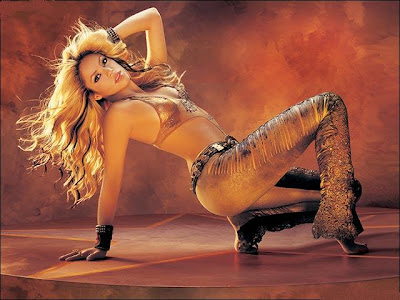|
|---|
Saturday, March 31, 2007
Jennifer Lopez launch her new Spanish language album "Como Ama Una Mujer" (How a Woman Loves) on March 28, 2007 to the delight of her hometown fans in Brooklyn. This is her sixth album and only effort in Spanish, which contains 11 pop songs is co-produced by Julio Reyes.
Check our previous post of Jennifer here.
Labels: Actress, American, music, Singer, Songwriter
Thursday, March 29, 2007
What can we control?
What is the part of reality that is actually controllable?
Say, when we take things in our hands.
And the beautiful thing is when someone manages to feel this point and use it, changing the vectors, but keeping the power, the energy, the impulse that the world drives through us.
Does that sound esoteric?
What is the fish doing in the church? What is the Holy water doing around the fish? Within the fish? It is all here, and the transgression is only a small part of the game. The name Sanctuary, to me, is not ironic. It is playful, yet strong.
Here?
Good work, Robert Wechsler.
(via)
Labels: painting/photo, sculpture
Wednesday, March 28, 2007
She appeared twice on the cover of the Sports Illustrated Swimsuit Issue in 1984 and again in 1985. She was also the cover model for the 20th Anniversary issue of Cosmopolitan magazine in November 1985.
Paulina was the first to be voted off from ABC's fourth season of "Dancing With the Stars", which began last week.
Tuesday, March 27, 2007
Monday, March 26, 2007
Aman's sultry persona was a contrast to many of the more conservative stars of the era. At a time when heroines were obedient wives and lovers on screen, Aman was drawn to more unique roles - she was cast as the opportunist who deserts her jobless lover for a millionaire (Roti Kapda Aur Makaan), the ambitious girl who considers aborting her baby to pursue a career (Ajnabee), the happy hooker (Manoranjan), the disenchanted hippie (Hare Rama Hare Krishna), the girl who falls in love with her mother's one-time lover (Prem Shastra), and a woman married to a caustic cripple but involved in an extramarital relationship (Dhund). She managed to balance these roles with acting in more conventional films such as Chori Mera Kaam, Chhaila Babu, Dostana and Lawaaris.
She appears rarely on screen now. She acted in Kaizad Gustad's film Boom in 2003 which also starts Amitabh Bachchan, Jackie Shroff, Gulshan Grover, Padma Lakshmi, Madhu Sapre and Katrina Kaif.
Sunday, March 25, 2007
Lilly placed eighth in the FHM 100 Sexiest Women in the World 2006 and placed second on Maxim's Hot 100 list of 2005 while #67 in Maxim's 2006 list.
Evangeline was hottest among USA Today's most gorgeous actresses on television from a recent poll conducted by TV Guide. Eva Longoria was second in this list.
Saturday, March 24, 2007
There are several excellent Polish sites about art. They focus mainly on Polish art and the Polish contemporary art milieu, and have a certain tendency toward a specialized and a high-brow discourse, but they have lots of good discoveries and insights and are a great reference point. And they're in Polish, which makes me one lucky bastard. Lucky for most of you, they also have lots of images of new Polish works. I recommend two: art.blox.pl and strasznasztuka ('terrible art')
From time to time, they also put on things happening outside of Poland. Below is a translation of one of the articles:
"Splasher" is now the hottest street-art name in New-York. Not because of what he makes, but because of what he destroys. Stencils, stickers and posters on the streets of Brooklyn and Manhattan have been for over a month the objects of the attack of the anonymous 'vandal'. Street art created by people as famous as Banksy or Swoon are destroyed in the same way - by a cruel splash of color paint.
The street art works, once considered only as acts of vandalism, are now themselves victims of a vandal. But is Splasher really just a street hooligan? It seems not. He chooses his goals very carefully - they are always the works of known artists, who have also often entered into the regular gallery circuit, and their works are sold at auctions for big money.
The mysterious Splasher is being looked for on the internet. Bloggers are looking for the motive of his actions. Many believe Splasher simply protests against the commercialization of street-art and against putting it in the same pot with classic works of art.
But what are Splasher's actual motives? Next to many of the works there were manifestos glued to the wall (one of them is reproduced below). They have references to dadaism and expressions like 'True creativity is the joyful destruction of this [existing] hierarchy'. Is Splasher the conscience of contemporary street art? Or a conceptual artist, who as part of an adopted theory of 'destruction' creates a new work of art?
New Yorkers don't appreciate Splasher's "art". The destruction of the works of known artists, such as Banksy, results in disapproval, and even anger. Splasher is not seen as the "savior and renewer", but as a simple vandal. Vandal among vandals? Or could Splasher be the last real street artist, who sacrifices famous murals and stencils in the name of a fight for the purity of the art form? Because what is the difference between street art and gallery art, if we can't destroy someone else's work at will in either place? After all, street art is based on an idea of destroying and lawlessly occupying space. Always at the cost of someone else. After all, the street is not a museum - every street artist, even Banksy, is subject to the same rules and accept that his work can be removed at any moment.
The question remains - do Splaher's desperate gestures make sense? Is it better to fight for a pure street-art, or to cherish its highest achievements?
(text by strembol)
more on Splasher here
And here is the idea that Splasher is a marketing ploy by the very people who promote street art as a commercial art form - this way they get free publicity (with a street-art war twist to it, apparently?).
The very idea shows us something new: that these are real people, existing in a real society, and obeying its laws. Whether they are perpetrators or victims, they participate in a social context. And its a relief to see how clearly they are integrated in it through the Splasher affair.
Labels: land art/urban
Friday, March 23, 2007
Can emotions shape our morality? Not only they can, but according to the great Portuguese neuro-scientist António Damasio, they do. Damasio has recently published an article in Nature which further develops the idea that our moral choices are very closely related to our emotions - also on a neurological level.
Face2Face is a simple idea: make both sides of a conflict see each other in the most human way possible. Show faces. Show them up close. Show them together. Show them as similar and - make them look funny.
So, if emotions can shape our moral decisions, the laughter could make it just a little harder to see the other as barbaric - unknown, distant, too-different.
Can this work? Can it be that simple? And I don't mean to suggest peace will happen because of a few posters. But can anything change? And why would we not believe in it, other than out of bitter and failing experience?Two small details. One: the use of a 28 mm macro lens. It is very hard not to look funny and cute seen from that angle. Two: the faces we see are combined in pairs of people with the same jobs (e.g. barbers, doctors, etc.).
See the video:
Labels: painting/photo, political
Thursday, March 22, 2007



 Finding the human form is easy. If you know where you're coming from. In some of Meinbert Gozewijn van Soest's recent work the head becomes just an apparently chaotic mash-up of lines and stains. One is tempted to think this is a head. One is tempted to empathize. But if we don't know anything else, what have we really got here? What is apparent? What remains?
Finding the human form is easy. If you know where you're coming from. In some of Meinbert Gozewijn van Soest's recent work the head becomes just an apparently chaotic mash-up of lines and stains. One is tempted to think this is a head. One is tempted to empathize. But if we don't know anything else, what have we really got here? What is apparent? What remains?
The beauty of lineage is that it tells you more than you should know. The figures entangled in their own lines, buried in a mass of accidents, undefined by the very form that describes them, tell us the story. The narrative, the line, the hermeneutic* identity of what would-have-been, all this appears to us if we go beyond the simple drawing of havoc. But can we actually defend this as a principle? Maybe not, but in pragmatic terms, if even the site invites us to a general, overall lecture, to a combining of various phases of Research, then I say, hey, go for it, beyond the Pandorra's box of a depressing painting, into the line that completes it, giving it an entire universe to refer to.
*I can't believe I'm actually using this creepy word...
Labels: painting/photo
Wednesday, March 21, 2007
Tuesday, March 20, 2007
In 2006, Thurman was named a knight of the Ordre des Arts et des Lettres of France for outstanding achievement in the field of art and literature.
The Tea Bag garden is a landscape made of stacked bags of garden soil. The bags, padded like a bench, are essentially soft plant containers. There were holes in it for planting herbs. Bey had planted mint at Z33 and left a boiler and tea set so that visitors can sit and make their own tea. Whenever a bag is empty, it is easily removed and replaced by another bag/plant pot. The bag garden can thus be peeled off, layer by layer.
The Vacuum Bag Furniture gives a real and surprising value to dust. The chair-shaped refuse bags can be connected to vacuum cleaners. Once filled with dust, they provide comfortable seating.
Different seats are packed in an elastic synthetic fibre to shape Family Cocoon.Regina over at WMMNA recently wrote about an exhibition by Jurgen Bey where these wonderful objects appeared (all descriptions are by her).
My favorite is the Family Cocoon, because it doesn't pretend to be practical. The Tea Garden could be considered as practical (although there seems to be something very not-real about it)(then again, I didn't drink the tea, did I), so it comes in a close second.
Labels: design/architecture
The thing that fascinates me about the Geostationary Banana Project, beyond the craziness and the scale, is the fact that it is a constant work-in-progress and is already functioning in the art world as a model of a work-to-be. This way of working is very inspiring.
There is something about taking away the edge of the Art Work that makes it, well, easier on the digestive system. When the experience of the work can be dissolved, so we don't just get it in one big lump, it can sometimes give a much-needed space of habituation. By that, I don't necessarily mean a context, an explanation, but more like a creative play between various aspects, levels, possibilities of something that otherwise risks being seen as, well, just a thing.
For instance, showcasing works on New Art is, for me, a way of seeing them in that space. Of seeing their possible links, connections (and readings as well...).
But in some artworks the dialog between various areas is what gives them a very rare power.
I probably wouldn't have noticed Jason Young's work.This type of work is something I would probably like to make - playing with resin has been a
personal fixation for a while. But I rarely actually stop to appreciate abstract plastic work, if it doesn't have a twist to it - some sort of a hidden agenda, so to speak. Of course, you might say if it's a good piece of work it only takes time and some effort to discover all the hidden agendas. Well, let's just consider that this can be ineffective.
On the other hand, I probably would have missed out on the fresh and creative video director Pascal Franchot. There is something about both of them that seems too slick, too cool...
Now, join them.
The above are stills from a film called The Curling Stones (or here in Quicktime). A film about creating a work of art. A film that is a documentary, because it documents the process of creating a work. But it is not a documentary (compare it to this), in that it clearly stages the whole thing. And doesn't even aspire to seem objective. It is a quasi-fiction. More: it looks, feels, moves like a commercial. The difference being - the result is a work of art. And maybe because the play stopped being about the pure material, the resin, the touch, or, on the other hand, the issue, the goal, the punchline, there is an artistic dialog here that gives value both to film and installation/performance. Brilliant.
Labels: film, painting/photo, performing
Saturday, March 17, 2007
At this stage, the blue-prints for the construction of the bamboo structure were finalized. The whole structure was developed with 3D software. As a result of this development, we know the amount of bamboo poles needed, we can zoom in to conflicting joints and see the details, we know the weight of the structure, the volume of gas needed, and so on. Also at this stage, we built and tested the gasbags that will be sandwiched between the bamboo rings that compose the structure. Finally, as a structural test, we built the smallest ring of the final banana - 16 meters in diameter.
Getting a 300-meter banana to float over 30 km up in the air, somewhere in the stratosphere. To be seen from all around Texas for a month.
The work, Geostationary Banana Over Texas, is by a known Canadian artist, Cesar Saetz. Its budget is about 1 million dollars. So far, they have a little more than 1/8, but the work keeps developing.
Comparable to... what? Cattelan's Hollywood? Christo and Jeanne-Claude? Smits' Cloud? Art-in-space programs? Surrealist games? Dada?
Labels: etc, funny, land art/urban
Thursday, March 15, 2007
Wednesday, March 14, 2007
Tuesday, March 13, 2007
Jones's career was launched with her massively successful 2002 debut album Come Away with Me, a contemporary pop album with a sensual, plaintive soul/folk/country tinge, which sold over twenty million copies worldwide and received eight Grammy Awards.
On January, 30, 2007, Norah released her third and most personla album yet, Not Too Late - a collection of 13 original songs debuted at #1 on the charts.
Marlene Dumas, whose watercolor painting was featured here a few days ago, is worth going back to.
Not because she is the most expensive living female artist. And not because she "embraces the totality of the human experience" (wow, people still actually write this sort of stuff...).
Oh, bloody hell.Oh, bloody hell.
I am as filthy as I am pure.
I think things, imagine things, crave for them or despise them.
This explicitness, this seeing more, or need to see more, is what brings me here.
To this site, to this artist. To this constant search for a name, a form, a way of channeling thirst.
Is it about sex? Is it about the blatancy of exposition?
Is it about humanity? About the loss of innocence? The search for meaning?
Is it about who we are? About our place in the order?
It certainly is about where the technique takes us. Yes, the technique. The way of putting things, of joining the clay.
One thing that irritates me is the often-repeated idea that Dumas is an artist "who knows no taboos". This is not only silly and sensationalist - it takes away the pleasure of discovering the exact lines of her taboo, her notions of decency, quite present and rich. Look at the above pictures as at a map of impossibilities, of what is not said. The form as subtraction.
See more Marlene Dumas here, here and here.
Labels: controversial, painting/photo
Monday, March 12, 2007
Rishi Kapoor's son Ranbir Kapoor will make his debut with Sonam Kapoor under Sanjay Leela Bhansali direction in the film titled Saawariya and is due for release in late 2007.
Zhang rose to fame due to her role in the phenomenally successful Crouching Tiger, Hidden Dragon, for which she won the Independent Spirit's Best Supporting Actress Award and the Toronto Film Critics' Best Supporting Actress Award.
In May 2006, Zhang became the youngest member to sit on the jury of the Cannes Film Festival. She was also included in People's 100 Most Beautiful People in the World in 2006.
Sunday, March 11, 2007
created through the apparently famous automatic net art generator...
Labels: digital

































